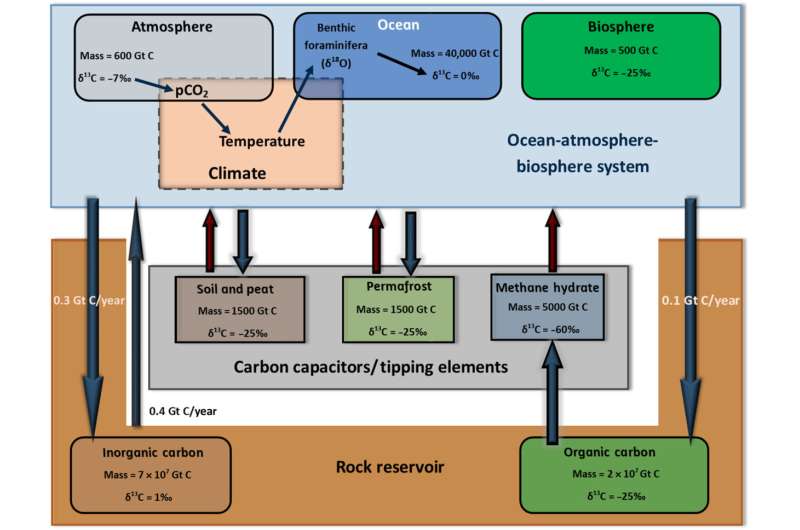This article has been reviewed according to Science X's editorial process and policies. Editors have highlighted the following attributes while ensuring the content's credibility:
fact-checked
peer-reviewed publication
trusted source
proofread
Past extreme climate warming triggered by tipping points, study finds

Can a rapid warming of Earth trigger tipping points in our climate? For decades scientists have debated if today's warming can strongly amplify itself by triggering a catastrophic release of greenhouse gases. New research, published in Science Advances, now presents evidence that such tipping points did occur in Earth's history. The researchers show that tipping points triggered three periods of extreme warming in the distant past, millions of years ago.
Earth has large underground reservoirs with huge quantities of stored carbon, like oil, gas and coal deposits. Besides these fossil fuels there are also other kinds of reservoirs in which carbon is stored. In Russia and Canada large amounts of carbon are preserved in permanently frozen soils, permafrost. In the ocean floor, millions of tons of methane are stored in an ice-like structure, called methane hydrates. As long as this carbon remains underground or frozen and does no enter the atmosphere as the greenhouse gases CO2 and methane, it won't contribute to climate change.
However, as temperatures on Earth keep rising, many climate scientists have cautioned these reservoirs could become unstable and lead to a tipping point: an abrupt release of huge amounts of greenhouse gases. Such a catastrophic release would, in turn, strongly increase climate change. The existence of tipping points hidden in our climate system has been debated for many years. It also has been argued that the climate system itself is sturdy and will prevent climate tipping points from being crossed.
The new research now shows for the first time that rapid global warming phases in the geological past, between 56 and 52 million years ago, were indeed caused by climate tipping points. It was already known that large amounts of CO2 and methane were released into the atmosphere during these phases, amplifying warming. This, in turn, destabilized other carbon reservoirs, triggering the release of more carbon. Global temperatures spiked even further—and this allowed the chain reaction to continue.
The research, a remarkable collaboration between mathematicians and Earth scientists from Wageningen University & Research and Utrecht University, shows that the sturdiness of the climate system decreased in the time period leading up to the phases of extreme warming. "This is exactly what you would expect to see if release of carbon was caused by a carbon cycle tipping point," explains mathematician Shruti Setty, Ph.D. candidate at Wageningen University & Research and first author of the paper.
"Never before has there been such a strong indication of the amplifying effects of tipping points during these heat spikes, which are considered to represent the best analogues of modern climate change in Earth's history," adds Margot Cramwinckel, assistant professor in Earth Sciences at Utrecht University and co-author of the paper.
"After crossing a tipping point, a new stable situation arises that is irreversible for a long time. From the perspective of a human life span, these changes can be described as permanent," says Setty.
"This type of irreversibility is observable in smaller systems on scales we can understand. For example, in Darvaza in Turkmenistan, a crater was formed releasing a steady stream of toxic gases. This was a new stable state which we could not reverse. Despite countless efforts, the crater still exists and continues to burn unabated. Perhaps the climate system today is very tough, and we never reach tipping points. However, we do not fully know the immensity of the risk. In the study, we present evidence for rapid climate change events induced by such tipping points in the distant past and this indicates that tipping points are part of Earth's system."
While the study showed that tipping points are present in the climate system—and that they can be triggered when global temperatures rise—the researchers couldn't pinpoint the carbon reservoir that became unstable. Even so, carbon reservoirs that most likely played an important role in the extreme warming phases still form important stores of greenhouse gases today. For this reason, the scientists caution, it is important to figure out how these historic global warming events occurred. Cramwinckel emphasizes, "Looking at the past is the only way to know how the Earth system is going to ultimately react."
More information: Shruti Setty et al, Loss of Earth system resilience during early Eocene transient global warming events, Science Advances (2023). DOI: 10.1126/sciadv.ade5466
Journal information: Science Advances
Provided by Wageningen University




















